Typical values at TA = +25°C, ADC
Sampling Rate = 2949.12 GHz. Default conditions: output sample rate = 491.52MSPS
(decimate by 6), PLL clock mode with fREF = 491.52 MHz, AIN =
–3 dBFS, DSA setting = 4 dB.
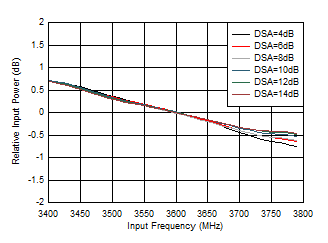
| With 3.6 GHz matching, normalized to 3.6 GHz |
|
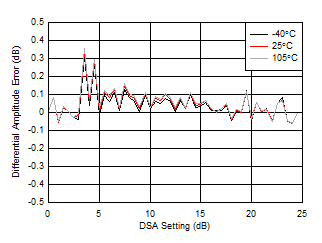
| With 3.6 GHz matching |
| Differential Amplitude Error = PIN(DSA Setting – 1) – PIN(DSA Setting) + 1 |
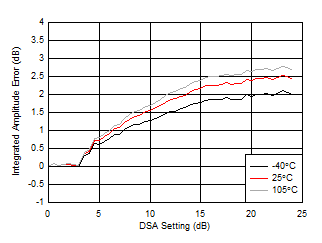
| With 3.6 GHz matching |
| Integrated Amplitude Error = PIN(DSA Setting) – PIN(DSA Setting = 0) + (DSA Setting) |
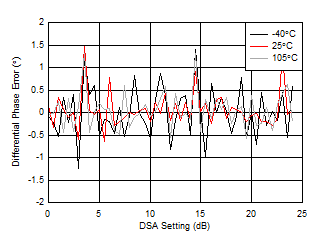
| With 3.6 GHz matching |
| Differential Phase Error = PhaseIN(DSA Setting – 1) – PhaseIN(DSA Setting) |
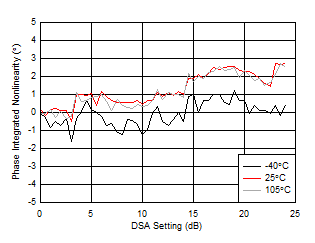
| With 3.6 GHz matching |
| Integrated Phase Error = Phase(DSA Setting) – Phase(DSA Setting = 0) |
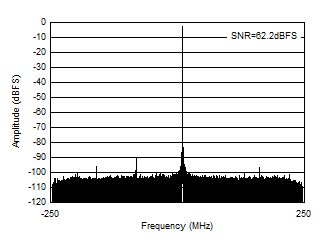
| With 3.6 GHz matching , fIN = 3610 MHz, AIN = –3 dBFS |
|
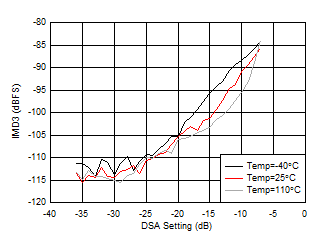
| With 3.5 GHz matching, 20-MHz tone spacing |
|
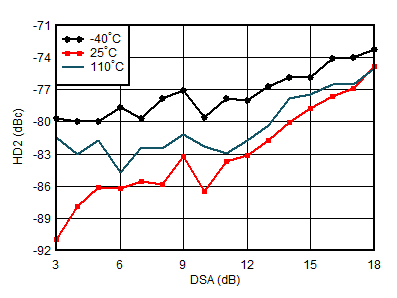
| With
3.5 GHz matching, DDC bypass mode (TI only mode for
characterization) |
Figure 6-396 RX
HD2 vs DSA Setting and Temperature at 3.6 GHz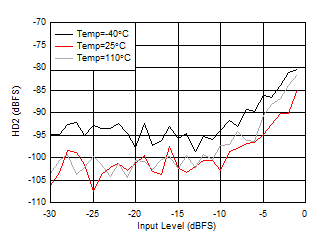
| With 3.5 GHz matching, DDC bypass mode (TI only mode for characterization) |
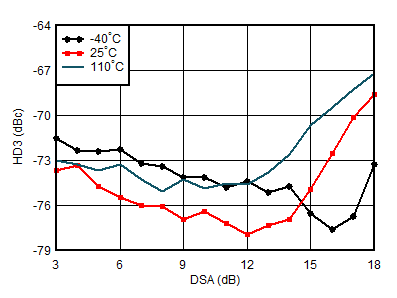
| With
3.5 GHz matching, DDC bypass mode (TI only mode for
characterization) |
Figure 6-400 RX
HD3 vs DSA Setting and Temperature at 3.6 GHz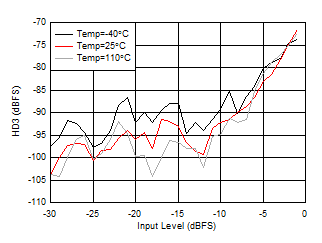
| With 3.5 GHz matching, DDC bypass mode (TI only mode for characterization) |
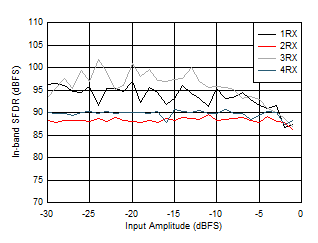 Figure 6-404 RX In-Band SFDR (±200 MHz) vs Input Level and Channel at 3.6 GHz
Figure 6-404 RX In-Band SFDR (±200 MHz) vs Input Level and Channel at 3.6 GHz
| With
3.6 GHz matching, –7 dBFS each tone, 20-MHz tone
spacing, all supplies at MIN, TYP, or MAX recommended
operating voltages |
Figure 6-406 RX
IMD3 vs Supply Voltage and Channel at 3.6 GHz
| With
3.6 GHz matching, tone at –20 dBFS, 12.5-MHz offset
frequency, all supplies at MIN, TYP, or MAX recommended
operating voltages |
Figure 6-408 RX
Noise Spectral Density vs Supply Voltage and Channel at 3.6 GHz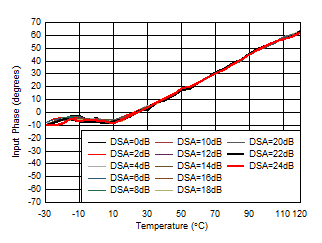
| With 3.6 GHz matching, normalized to phase at 25°C |
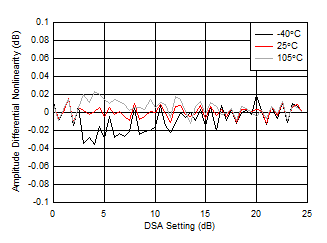
| With 3.6 GHz matching |
| Differential Amplitude Error = PIN(DSA Setting – 1) – PIN(DSA Setting) + 1 |
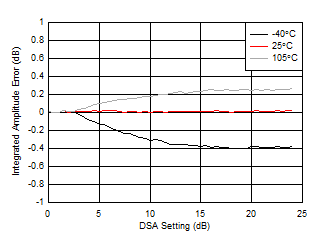
| With 3.6 GHz matching |
| Integrated Amplitude Error = PIN(DSA Setting) – PIN(DSA Setting = 0) + (DSA Setting) |
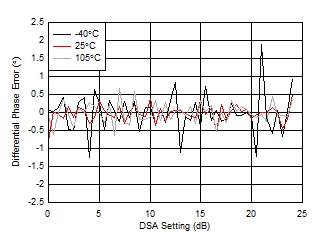
| With 3.6 GHz matching |
| Differential Phase Error = PhaseIN(DSA Setting – 1) – PhaseIN(DSA Setting) |
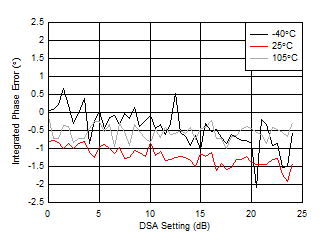
| With 3.6 GHz matching |
| Integrated Phase Error = Phase(DSA Setting) – Phase(DSA Setting = 0) |
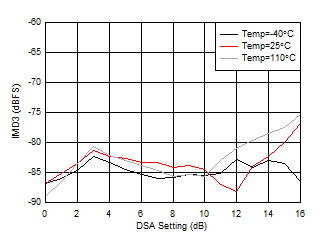
| With 3.5 GHz matching, each tone at –7 dBFS, 20-MHz tone spacing |
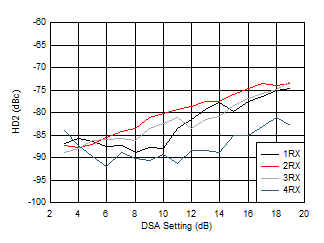
| With 3.5 GHz matching, DDC bypass mode (TI only mode for characterization) |
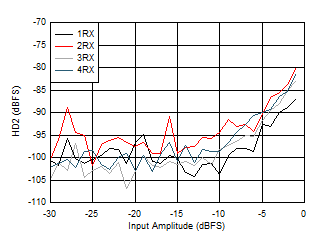
| With 3.5 GHz matching, DDC bypass mode (TI only mode for characterization) |
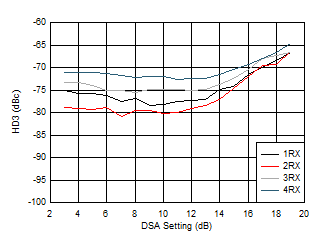
| With 3.5 GHz matching, DDC bypass mode (TI only mode for characterization) |
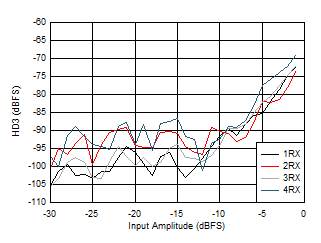
| With 3.5 GHz matching, DDC bypass mode (TI only mode for characterization) |
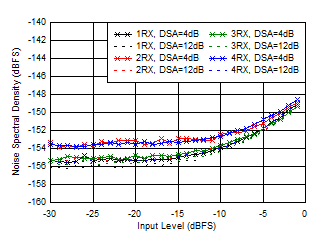
| With 3.5 GHz matching, 12.5-MHz offset from tone |
|
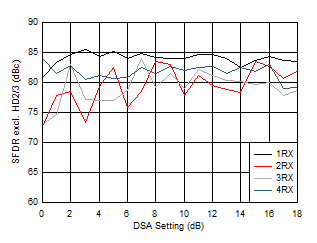 Figure 6-405 RX SFDR Excluding HD2/3 vs DSA Setting and Channel at 3.6 GHz
Figure 6-405 RX SFDR Excluding HD2/3 vs DSA Setting and Channel at 3.6 GHz
| With
3.6 GHz matching, –7 dBFS each tone, 20-MHz tone
spacing, all supplies at MIN, TYP, or MAX recommended
operating voltages |
Figure 6-407 RX
IMD5 vs Supply Voltage and Channel at 3.6 GHz

























